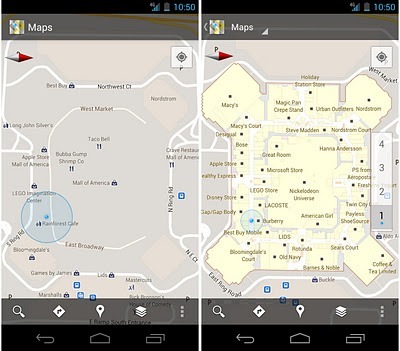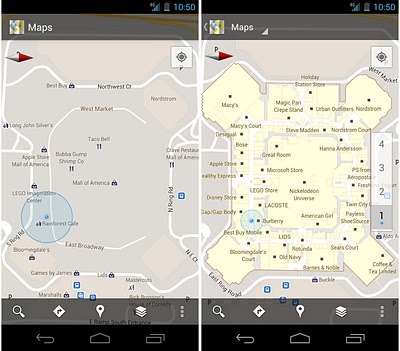
Google’s Maps go indoors; digital wayfinding guys twitch
November 29, 2011 by Dave Haynes
[youtube id=”Gy-DI_bWElg” width=”600″ height=”350″]
If your company has been developing wayfinding applications, particularly for things like airports and malls, you’ve probably been thinking Google might present a bit of a problem at some point.
That point appears to have arrived, with Google’s announcement that the maps it serves up that allow billions of people to get from here to there will also know help people find their way inside the “there” part of the journey.
Google Maps for Android devices – phones and tablets – now enables users to figure out where they are and where they might want to go once inside.
Starting today, says the Google mapping team’s blog, with the release of Google Maps 6.0 for Android, that directory is brought to the palm of your hands, helping you determine where you are, what floor you’re on, and where to go indoors.
Detailed floor plans automatically appear when you’re viewing the map and zoomed in on a building where indoor map data is available. The familiar “blue dot” icon indicates your location within several meters, and when you move up or down a level in a building with multiple floors, the interface will automatically update to display which floor you’re on. All this is achieved by using an approach similar to that of ‘My Location’ for outdoor spaces, but fine tuned for indoors.
- Mall of America, IKEA, The Home Depot, select Macy’s and Bloomingdale’s, Daimaru, Takashimaya and Mitsukoshi locations and more. Watch an IKEA demo here.
- Hartsfield-Jackson Atlanta International Airport (ATL), Chicago O’Hare (ORD), San Francisco International Airport (SFO) and Narita International (NRT), among others.
- JR and Tokyu Corporation
For a detailed list of participating locations, please visit our help center. And this is just the start–we’ll continually add new indoor maps to public buildings across the world. If you’re a business owner interested in getting your location’s floor plan included in Google Maps, visit maps.google.com/floorplans.
So what does this mean for the interactive wayfinding companies? Probably too early to say.
Right now it is a mobile application meant for people who are walking around clutching their Android handset or tab. But it will not be long before we see digital signage devices running off Android in something more significant than test lab benches.
What will clearly differentiate what the digital wayfinding guys do is the visual look and feel and the much tighter, layered and interesting spin they can do. Google Maps are awesome, but by the sheer demands of scale, are pretty vanilla in their look.
There might actually be some interesting integration to start people off on the big wayfinders you see in places like airports and push them through some Google interface to the handsets.




Many shopping centers have their indoor wayfinding with 3D maps: http://www.3dwayfinder.com/